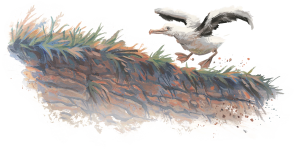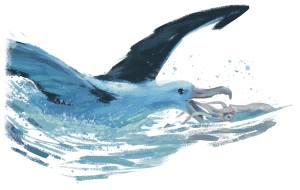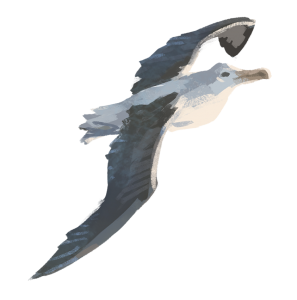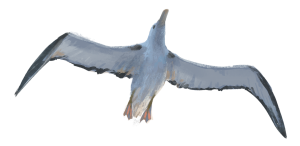In 2008, a transmitter was attached to the 500th chick hatched at the Albatross Centre. This is Toroa’s story of his tracked journey to Chile and beyond. What happened to him on his 8-year journey? Did he return to New Zealand? Beautifully realised with Gavin Mouldey’s vibrant gouache paintings and award-winning Maria Gill’s meticulous research. Told in story format with extra fascinating fact boxes.
for children
Activity One (partner activity)
Make a pair of 3-metre-long wings (total length) for an albatross out of paper and rulers.
Activity Two
Make an albatross mask out of card. Colour it in (paint, crayon, pastel).
Activity Three
Gavin Mouldey painted the illustrations with gouache paints, wood stain and pastels. Toroa was painted digitally using a drawing tablet and stylus. The 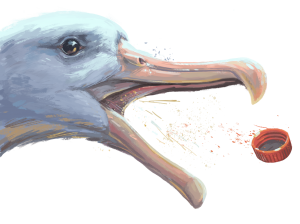 plastic patch illustration contains actual trash washed up on Kapiti beach. Organise a beach clean-up, and create a collaged artwork from found plastic.
plastic patch illustration contains actual trash washed up on Kapiti beach. Organise a beach clean-up, and create a collaged artwork from found plastic.
Activity Four (group of 4–6)
Act out the story. Have 1–2 narrators who read the story. One person to act as the main character, Toroa. Other characters are female albatross, mother, chick, ranger, and these characters could also act as the fishermen. Perform in front of the class/school.
Activity Five
Design a poster to raise awareness of the plight o f the albatross. It could be about the plastic rubbish in the sea that albatross eat and then die. Or it could be about the predators we need to control so that their chicks can survive.
f the albatross. It could be about the plastic rubbish in the sea that albatross eat and then die. Or it could be about the predators we need to control so that their chicks can survive.
Activity Six
Help make a difference for the albatross! Start a movement at your school/local community to be plastic free. Make some stickers to encourage people to take their cloth bags to the supermarket. And/or make some cloth bags for your family to use.
maria gill – author
 Maria Gill circumnavigated the world in her back-packing days. Today you’ll find her writing full-time in the sea-side village of Point Wells. Maria has written over 54 books for children and teachers. Anzac Heroes won the 2016 Elsie Locke Award for non-fiction and the Margaret Mahy Book of the Year Award. Her book New Zealand Hall of Fame won the Non-fiction Children’s Choice in 2012. While on a trip to Dunedin, Maria visited the Albatross Centre and interviewed the ranger about Toroa. She then waited eight years before sending it to Potton & Burton because she wanted to see if Toroa made it back to Dunedin. mariagill.co.nz
Maria Gill circumnavigated the world in her back-packing days. Today you’ll find her writing full-time in the sea-side village of Point Wells. Maria has written over 54 books for children and teachers. Anzac Heroes won the 2016 Elsie Locke Award for non-fiction and the Margaret Mahy Book of the Year Award. Her book New Zealand Hall of Fame won the Non-fiction Children’s Choice in 2012. While on a trip to Dunedin, Maria visited the Albatross Centre and interviewed the ranger about Toroa. She then waited eight years before sending it to Potton & Burton because she wanted to see if Toroa made it back to Dunedin. mariagill.co.nz
gavin mouldey – illustrator
 Gavin Mouldey found his passion for art when still scribbling and exploring paint splats. While cartooning for newspapers as a teenager he learnt that messy accidents often improved his art. After completing a bachelor’s degree in graphic design Gavin lived around the world while drawing for journals, books, greeting cards, animation, games and walls. Eventually he returned to New Zealand to build a nest by the sea, where he illustrates full time. For Forest & Bird’s Wild Things magazine, Gavin regularly illustrated native bird species, which inspired his involvement with Toroa’s Journey. He also created the art for the international award-winning Game of Awesome, a literacy resource for NZ schools. dittybox.co.nz
Gavin Mouldey found his passion for art when still scribbling and exploring paint splats. While cartooning for newspapers as a teenager he learnt that messy accidents often improved his art. After completing a bachelor’s degree in graphic design Gavin lived around the world while drawing for journals, books, greeting cards, animation, games and walls. Eventually he returned to New Zealand to build a nest by the sea, where he illustrates full time. For Forest & Bird’s Wild Things magazine, Gavin regularly illustrated native bird species, which inspired his involvement with Toroa’s Journey. He also created the art for the international award-winning Game of Awesome, a literacy resource for NZ schools. dittybox.co.nz
for parents and teachers
Comprehension questions can be printed out HERE or you can ask children verbally:
Cover and back cover questions
- Look at the front and back covers, discuss what type of book it is. Is it non-fiction or a creative non-fiction story about an albatross?
- Where do you think Toroa journeys to?
- Why do you think the illustrator has drawn two types of pictures? What does it say about the type of artist he is?
- What is ‘down’?
- Where has the mother been, do you think?
- What is slurried seafood?
- When and where did Toroa hatch?
- What does Toroa mean in English?
- What is significant about this albatross chick?
Pages 4–5 questions
- Why is Toroa exercising his muscles?
- What type of seabird is the largest in the world?
- How many species of albatross are there?
- Who preys on albatross chicks?
Pages 6–7 questions
- Why does Toroa wait for a blustery morning?
- Why does Toroa waddle toward the cliff?
- What was attached to Toroa?
- Why would the ranger attach it to the albatross?
- Why has the publisher and illustrator made the bird’s wings so big on this page?
- How long is the wingspan of a royal albatross?
- How far can an albatross fly in an hour?
Pages 10–11 questions
- What verbs describe the albatross flight pattern?
- What simile did the author use to describe the albatross flight pattern?
Pages 12–13 questions
- Where is the albatross kingdom?
- What has Toroa seen in the ocean?
- What senses do albatross use to navigate and find prey?
- Why do you think the fishermen are dumping fish scraps over the side of the boat?
- What has scared Toroa off?
- What do responsible fishermen do to scare off seabirds so they don’t catch them by mistake?
Pages 16–17 questions
- Why is Toroa hungry?
- How does he fill himself up?
- How does he get rid of the salt in the seawater?
- How many kilometres has Toroa flown to get to South America?
Pages 18–19 questions
- What type of foods do albatross eat?
- How does an albatross get airborne again?
- What simile has the author used to describe how albatross sit on the ocean?
- Give an example of alliteration (words beginning with the same letter/sound) and assonance (words with similar sounds) on this page.
- What do you think is vibrating the water?
- What is Chaiten’s plume?
- When did Chaiten erupt?
- When did the Albatross Centre lose track of Toroa?
Pages 22–23 questions
- What type of island does Toroa land on in the water?
- What do you think Toroa has swallowed?
- What are grit stones?
- How many plastic water bottles are thrown away every year?
Pages 24–25 questions
- Why do you think albatross eat the plastic?
- What else did Toroa cough up?
- How many albatrosses are estimated to die every year?
- How many bits of plastic were found in a dead albatross?
- How old is Toroa now?
- Where does Toroa fly to?
- How does he brake when landing?
- When did Toroa arrive?
- How many albatrosses make it back to Taiaroa Head every year?
Pages 28–29 questions
- What is Toroa doing on this page?
- How long do partnerships usually last?
- How long do albatross usually live on average for?
Pages 30–31 questions
- What is courting?
- Why is their nest barren for the first two years, do you think?
- Who was Toroa’s grandmother and why was she famous?
Page 32–33 questions
- What do albatross use to build their nests?
- Who incubates the egg?
- How long does it take for an albatross to fledge?
- What is carrion?
- What is a pinger?
- What type of animals are cephalopods?
- When did Toroa’s chick hatch?
Science Curriculum, Living World, Levels 1-2
Students will:
- Life processes
- Recognise that all living things have certain requirements so they can stay alive
- Ecology
- Recognise that living things are suited to their particular haitat.
Level 3
- Life processes
- Recognise that there are life processes common to all living things and that these occur in different ways
- Ecology
- Explain how living things are suited to their particular habitat and how they respond to environmental changes, both natural and human-induced.



